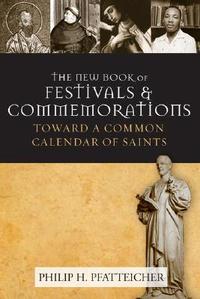New Book of Festivals & Commemorations
A Proposed Common Calendar of Saints
Philip H. Pfatteicher
Fortress Press, Minneapolis
2008
Over 700 pages when you count introduction, appendixes, etc.
The Lord be with you
First of all, I want to say that Philip Pfatteicher has taken on an impossible task. His hope for a common liturgical calendar for liturgical churches is simply not going to happen. There are too many denominations with their own particular “heroes of the faith” to incorporate them all. Along with that, the differences between denominations, theologically, will mean more than a few individuals would be incorporated into such a calendar that others would feel advocated false teachings.
 Now that that is out of the way, this is a great book! Pfatteicher has done remarkable research, consulting both current and historic liturgical calendars. He has also incorporated many events and individuals that, while quite significant, are often overlooked (for example, June 3 is used to remember the Martyrs of Uganda 1886). With each entry he provides an article, a list for further reading, a selected reading (if an individual is being remembered then typically the reading is something from the individual), a collect (short prayer) of the day, suggested scripture lessons, a suggested “hymn of the day,” bullet points for other appropriate prayers, a suggestion to use for the “preface” if you plan to celebrate the Lord’s Supper, and a suggested liturgical color.
Now that that is out of the way, this is a great book! Pfatteicher has done remarkable research, consulting both current and historic liturgical calendars. He has also incorporated many events and individuals that, while quite significant, are often overlooked (for example, June 3 is used to remember the Martyrs of Uganda 1886). With each entry he provides an article, a list for further reading, a selected reading (if an individual is being remembered then typically the reading is something from the individual), a collect (short prayer) of the day, suggested scripture lessons, a suggested “hymn of the day,” bullet points for other appropriate prayers, a suggestion to use for the “preface” if you plan to celebrate the Lord’s Supper, and a suggested liturgical color.
He is careful to site his sources and to tell us which traditions recognize which days. If you are not familiar with liturgical calendars, he provides a classification system for the days (five different types) which is a bit more complex then the classification used in the LC-MS (three different types) but not as complex as some denominations.
This is a great resource book for pastors but should not be overlooked by the laity. It is a wonderful book to introduce anyone to the breath and depth of our common Christian history and tradition. His calendar spans over twenty centuries of notable believers and events (Old Testament people and events are present).
The suggested calendar has only days that are fixed by the solar calendar. Those dates that are determined by the lunar year (and therefore fall on different dates each year in reference to a solar calendar) are not included. This leaves out such holidays like Maundy Thursday, Good Friday, Easter, Pentecost, etc.
Another issue with any liturgical calendar that seeks to be so comprehensive is that it tends to overshadow the Church Seasons (Advent, Lent, Pentecost [or Common], etc.). With this calendar, roughly two-thirds of the days in a year have some sort of holiday assigned.
One final observation: Pfatteicher deliberately seeks to be ecumenical. What that means is that the people and events recognized cross most theological boundaries. You will find Roman Catholics, Lutherans, Baptists, Methodists, Eastern Orthodox, etc. represented. That means that you will, no doubt, find some individuals or events commemorated which you think should not be represented (and, of course, some for which you might want to sing the Te Deum). Try not to throw the baby out with the bathwater.
All in all, this is an excellent resource book. I find myself returning to it often as I do research, or just for some devotional reading.
Blessings in Christ,
Pastor
